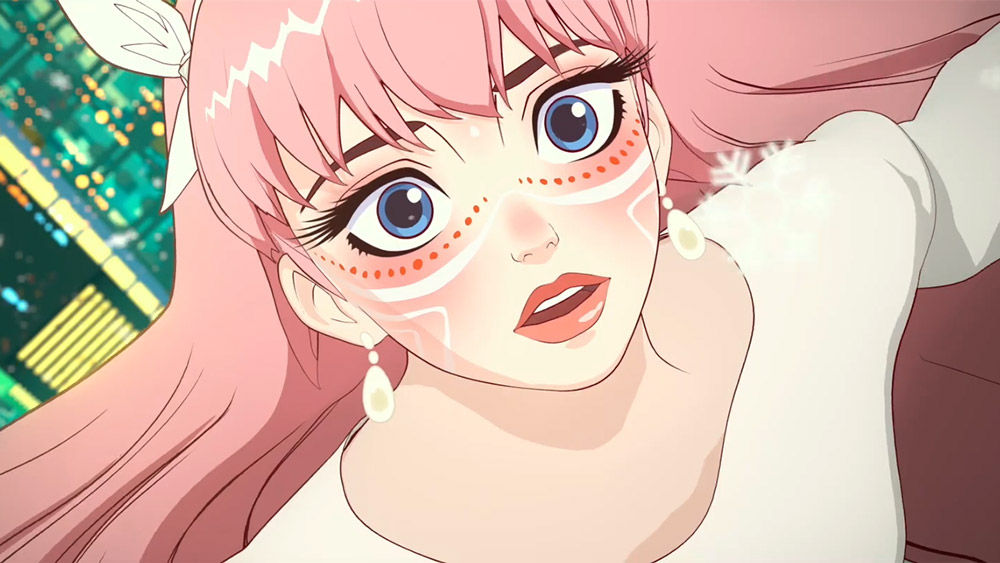If a name can trigger nostalgia, don’t be surprised when the occasional sense of deja vu sets in while watching Belle, a dazzling near-future tech fantasia wrapped around a tale, yes, as old as time. Directed by Mamoru Hosoda and mostly set in a vast online world of sweeping musical numbers and weightless action sequences, it tells of Suzu, an awkward teenager (as if there were any other kind) who finds quick fame performing as the pop-singer Belle: her avatar on a hugely popular social media platform called U that looks like a sugary cocktail of Tik Tok and “The Oasis” from Spielberg’s Ready Player One.
Belle is the most ambitious work yet from Hosoda, a filmmaker who—along with contemporary Makoto Shinkai, director of the massively successful Your Name—has for quite some time been touted as heir apparent to Hayao Miyazaki (though Hosoda tends to balk at the suggestion). His career trajectory has been notable: from honing his craft on a series of Digimon films at the beginning of the century; to an ill-timed stint at Studio Ghibli, where he was meant to direct Howl’s Moving Castle; to Madhouse where, in 2006, he hit prominence with The Girl Who Leapt Through Time; to setting up Studio Chizu with longtime producer Yuichiro Saito in 2011. Seven years and four projects later they released Mirai and went to the Oscars.
Belle premiered this summer at the Cannes Film Festival—a rare event for an animation, rarer yet for an anime, and a sure marker of that ascendency. It received a 14-minute standing ovation, perhaps unsurprisingly with its wash of spectacle and sincerity, ohrwurm tunes, and big emotions (if not an occasionally lachrymose tone and slightly rushed first act). The protagonist, Suzu (voiced by Kaho Nakamura, who also sings), is your average anime lead: white shirt, navy skirt, eternally embarrassed. She shies away in school and finds nothing more mortifying than when her crush, a brooding boy who once looked out for her when they were kids, deigns to start a conversation. Near the beginning of Belle, Hosoda reveals the most formative experience of Suzu’s life: witnessing her mother swim out into a roaring river to save an infant and not come back alive. (She is supported throughout the story by an endearing gaggle of her mother’s old friends.)
Hosoda’s story is about teen angst and getting out of your shell, and an atypically hopeful take on the Internet. There are the familiar images of humans gazing intimately into glowing devices, but his film is curiously less a finger-wagging warning than a frank, even optimistic view of the relationship young people have with life online—U is, after all, where Suzu escapes the confines of her insecurities. Designed by Hosoda and his army of animators, this platform is a sprawling, minutely detailed landscape of flickering yellow and orange that suggests something between a circuit board and a cityscape, huge portions of its 6 billion users flying above and interacting. Dotted amongst it are grand buildings, epic concert halls, and even some darker hidden corners—like the castle where a scarred, wolf-like avatar holds up when he isn’t brawling with the platform’s mildly fascistic team of digital law enforcers. In U, a body or form is generated for the user when they sign up that is meant to reflect their own personality traits. Though most everyone in U fears the wolf, Belle sees a lost soul, maybe a kindred spirit, and the discovery of one’s true self becomes Belle‘s key theme.
If Hosoda’s film suffers from anything it is a sense of whiplash. Not 15 minutes of its lengthy running time have passed before shy, tuneless Suzu is transformed into a world-conquering pop sensation, appearing on the digital landscape in full song, riding a blue whale through U’s skyline to the rapturous appreciation of her fans. (Hosoda’s explanation for Suzu’s performances and songwriting ability, far as I could gather, is simply that her friend is good at computers.) Navigate these opening exchanges, however, and there is plenty to appreciate. Belle is less an homage to Beauty and The Beast than a kind of cover song: more than following many of the same beats, Suzu’s online journey seems to mimic some of its most famous shots and the way the characters move. Even snippets of dialogue are taken almost verbatim. It creates an intriguing sense of the uncanny that is much different to, somehow richer than the nostalgia shot of—again a relevant comparison—Ready Player One.
That section is only a lengthy chapter within Suzu’s wider “real world” story: a moving, melancholic melange of absent parents (and abusive ones), loving friends, and surprising comedy—most notably a side romance between a goofy canoeist and the most popular girl in school. Yet it provides an anchor and a centerpiece to Hosoda’s film; and it culminates, as such things often do, on a starry night and a huge swooning ballad. If you were lucky enough to have caught it on the Piazza Grande in Locarno this year, on a balmy August evening under the stars, it probably hit the mark.
Belle screened at Locarno Film Festival and will be released by GKIDS.

